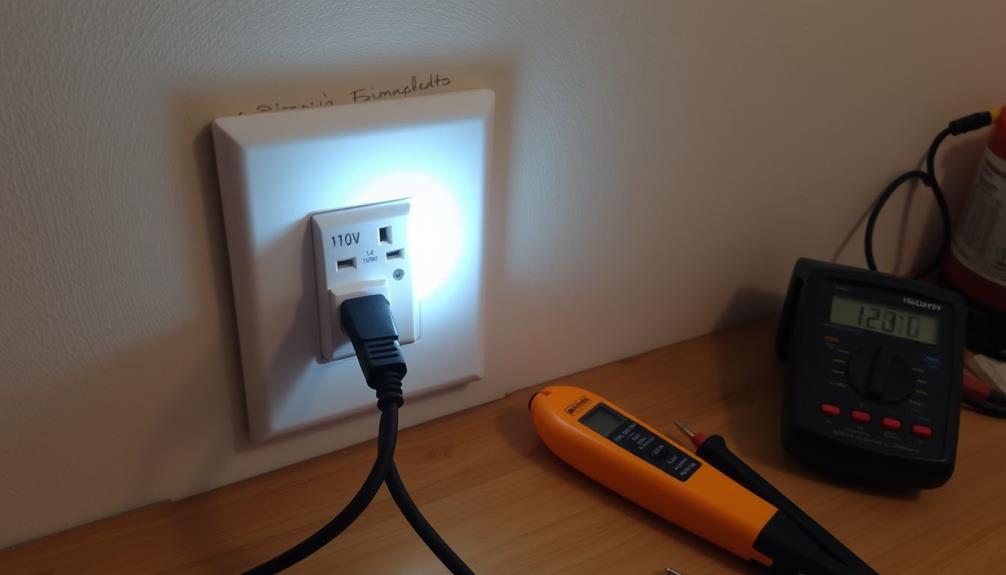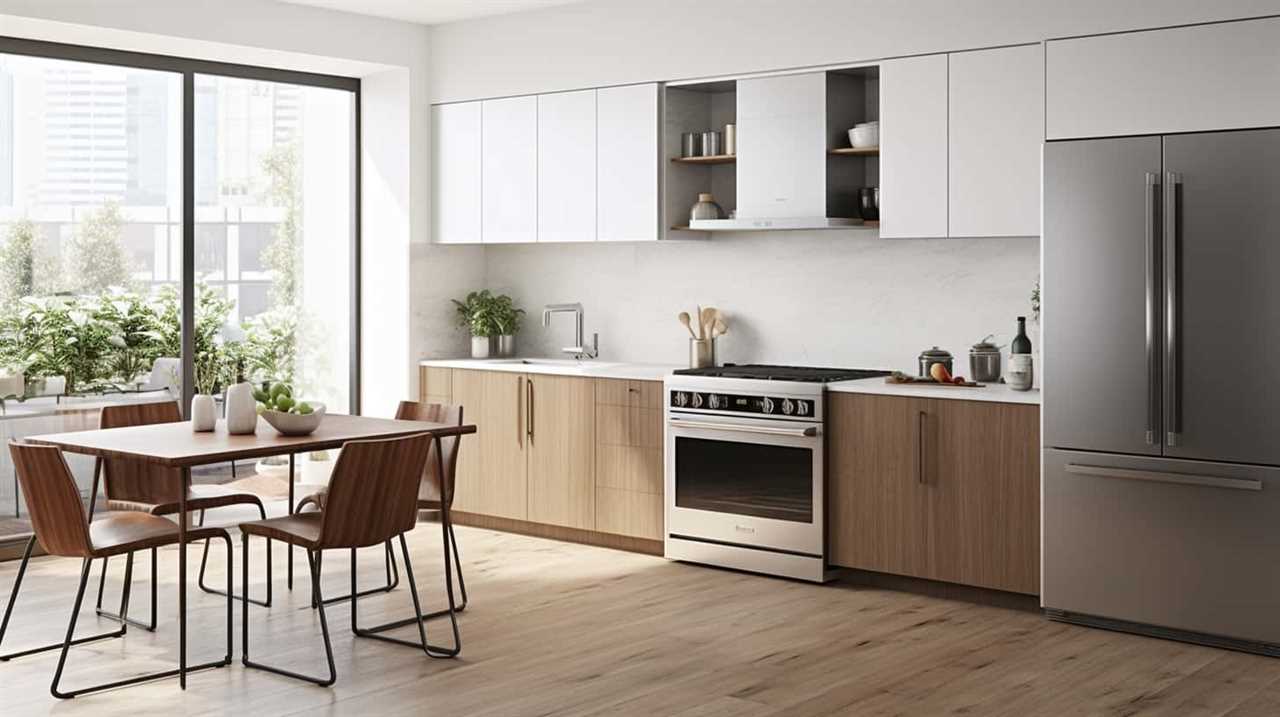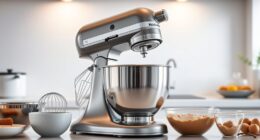In order to troubleshoot common issues with your dishwasher, you should begin by checking for dirty dishes, leaks, or unusual noises. Be sure to inspect the spray arms for any blockages and clean them regularly. Look out for leaks around the door seals and hoses, and check the drain for any clogs if you notice water pooling. Make sure the dishwasher is turned on and that the door latch is functioning properly. If your dishwasher is making a lot of noise, it’s a good idea to check for any foreign objects in the pump. If you continue to experience problems or error codes, it may be time to seek assistance from a professional. Keep reading for more tips on maintaining a dishwasher that works efficiently.
Key Takeaways
- Check power connections and ensure the circuit breaker is not tripped for startup issues.
- Inspect and clean spray arms to prevent clogs and improve washing efficiency.
- Examine door seals and hoses for wear or damage to address leaks.
- Clear drain filters and hoses of clogs to resolve water pooling issues.
- Refer to the user manual for specific error codes or flashing lights indicating problems.
Common Dishwasher Problems
When you unload your dishwasher, you expect sparkling clean dishes, but that's not always the case. You might notice dirty dishes due to common dishwasher problems like clogged spray arms. Regularly cleaning these can help restore performance and prevent poor cleaning results.
To maintain a clean home environment, consider hiring a professional home cleaning service to assist with routine tasks. If you find water pooling at the bottom, your dishwasher drain is clogged, which needs immediate attention.
Another issue could be leaks caused by damaged door seals or hoses; a thorough inspection will help identify any worn components. If your dishwasher is noisy during operation, it might indicate foreign objects in the pump or worn parts, so regular maintenance is vital.
Dishes not drying properly could signal a malfunctioning heating element. Testing this component with a multimeter guarantees it's working correctly.
Also, if your dishwasher won't start, check the door latch and the power supply. Sometimes, tripped circuit breakers or unplugged cords can cause startup failures.
Step-by-Step Troubleshooting Guide

If you're facing issues with your dishwasher, a step-by-step troubleshooting guide can help you pinpoint and resolve the problem efficiently. Start by checking the power supply; verify the dishwasher is plugged in, the circuit breaker isn't tripped, and the door latch is secure. If the control panel shows no signs of life, this step is essential.
Next, inspect the spray arms for clogs. Dirty dishes often result from blocked spray arms, so cleaning them can enhance performance. If you notice leaks, examine the door seals and hoses for wear or damage.
For drainage issues, check the drain filter and hose for clogs, and verify the sink drain is clear. Finally, if problems persist, consult your user manual for error codes or flashing lights, which can help you identify specific issues needing attention.
Here's a quick reference table to guide you through troubleshooting:
| Step | Action | Notes |
|---|---|---|
| Check Power | Verify it's plugged in and circuit's fine | Secure door latch |
| Inspect Spray Arms | Look for clogs | Clean as needed |
| Examine Leaks | Check door seals and hoses | Replace if damaged |
| Check Drainage | Inspect drain filter and hose | Clear any clogs |
| Refer to Manual | Look for error codes | Identify specific issues |
Cleaning and Maintenance Tips

To keep your dishwasher running smoothly, make sure you regularly clean the filter and check the spray arms for clogs.
Regular servicing of your appliances, including dishwashers, can greatly boost their efficiency and lifespan, just like the importance of HVAC maintenance.
This simple maintenance can boost your machine's cleaning performance and extend its lifespan.
Let's look at how you can effectively tackle these tasks.
Regular Filter Cleaning
A clean dishwasher filter is essential for peak performance and hygiene. Regular filter cleaning helps prevent clogs that can hinder cleaning performance and lead to unpleasant odors. You should aim to clean the filter every month to maintain efficient water circulation, ensuring you get cleaner dishes.
To clean the filter, remove it from the bottom of the dishwasher. Rinse it under warm water to eliminate any food particles and debris. Use a soft brush or cloth to scrub it gently, making sure all crevices are free from buildup that could obstruct water flow. Always check your user manual for specific instructions tailored to your dishwasher model to avoid any damage during cleaning.
Here's a quick overview of the benefits of regular filter cleaning:
| Benefit | Impact on Performance | Result |
|---|---|---|
| Prevents clogs | Improves water circulation | Cleaner dishes |
| Reduces odors | Maintains hygiene | More pleasant kitchen |
| Enhances efficiency | Minimizes need for appliance repair | Saves on repair costs |
Spray Arm Maintenance
The spray arms in your dishwasher are fundamental for delivering water to every dish during a wash cycle. Regular maintenance is essential to guarantee ideal cleaning performance.
Start by removing the spray arms and inspecting them for clogs. Blockages in the nozzles can greatly hinder water flow, leading to poor cleaning results. Additionally, be mindful of clogging remedies that can apply to various plumbing issues, including dishwashers.
To clean the spray arms, mix equal parts of vinegar and water. This solution helps dissolve mineral buildup that can affect their efficiency. Aim to perform this cleaning at least once a month.
It's also crucial to check for any obstructions that might prevent the spray arms from rotating freely during operation. Make sure no utensils or improperly loaded dishes are blocking their movement.
After cleaning, reattach the spray arms securely to prevent leaks and maintain water pressure during cycles. If you notice any damage or wear, consider replacing them, as faulty spray arms can greatly impact your dishwasher's cleaning effectiveness.
Repair Techniques for Common Issues

When your dishwasher isn't performing as it should, identifying common issues is key.
Regular maintenance, much like that required for pool heaters, can help prevent problems.
You'll want to check for clogged spray arms, leaky door seals, and any drainage problems.
Let's look at some straightforward repair techniques to get your dishwasher back in top shape.
Clogged Spray Arms
Clogged spray arms can seriously hinder your dishwasher's performance, making it crucial to address this common issue promptly. When the spray arms are obstructed, you'll notice a drop in cleaning efficiency and poor water circulation. Regularly inspect and clean the spray arm nozzles to guarantee peak water flow.
Here's a quick guide to troubleshooting clogged spray arms:
| Step | Action |
|---|---|
| 1. Remove Spray Arms | Detach the spray arms from your dishwasher. |
| 2. Soak and Scrub | Soak in vinegar and warm water; scrub with a small brush. |
| 3. Check for Blockages | Use a toothpick to dislodge stubborn food particles. |
Additionally, check the dishwasher filter regularly; a dirty filter can contribute to clogged spray arms. If cleaning doesn't resolve the issue, inspect the water inlet valve for proper function. Confirm it's allowing adequate water flow to maintain cleaning efficiency. If necessary, clean or replace any components that aren't performing well. By staying on top of these maintenance tasks, you can keep your dishwasher running smoothly.
Leaky Door Seals
Maintaining your dishwasher's performance isn't just about keeping the spray arms clean; leaky door seals can also lead to inefficiencies and messes.
Start by inspecting the door seals for any cracks, tears, or debris that may prevent proper sealing. If you spot any buildup, make sure to clean the gasket with mild soap and water. This simple step can often resolve issues.
Additionally, verify that the air quality in your kitchen is ideal, as poor air circulation can lead to increased humidity and potential mold growth, which might affect your dishwasher's seals. For more information on improving air quality, consider exploring air purifiers for better health.
Next, check the door alignment. Confirm that nothing, like large dishes, obstructs the door from closing completely. A misaligned door can create gaps that lead to leaks.
Additionally, test the door latch to confirm it clicks securely when closed. If it fails to engage, you'll need to replace the latch to maintain a tight seal.
Don't forget about the door spring; it plays a role in keeping the door closed properly.
Regularly inspect and clean the door channel and gasket area since trapped food particles can contribute to leakage over time.
If your seals are worn or damaged, consider replacing them with OEM parts to maintain ideal sealing and prevent leaks.
Taking these steps will keep your dishwasher running smoothly.
Drainage Issues
Over time, drainage issues can be a common headache for dishwasher owners. You'll want to tackle these problems head-on to avoid standing water lingering at the bottom of your machine. Start by checking the drain hose for kinks or clogs, ensuring it's positioned correctly as per the manufacturer's guidelines.
Next, inspect and clean the drain filter regularly. Food particles and debris can accumulate here, leading to further drainage issues. Don't forget to check your sink's drain, as a blockage there can also prevent proper drainage from your dishwasher.
If your dishwasher isn't draining, listen for sounds from the drain pump during the cycle. No sound means it might need replacement. Finally, running a diagnostic test can help pinpoint specific issues, making troubleshooting easier.
| Problem | Solution |
|---|---|
| Clogged drain hose | Inspect and clear |
| Dirty drain filter | Clean regularly |
| Faulty drain pump | Replace if silent |
Safety Considerations During Repairs

When working on your dishwasher, safety should always come first. To guarantee a safe repair process, follow these essential steps:
1. Disconnect the Power: Always turn off the power by unplugging the dishwasher or switching off the circuit breaker. This prevents any risk of electrical shock while you're working.
Additionally, it's wise to review local zoning laws and regulations regarding appliance repairs, as certain areas may have specific guidelines to follow.
2. Use Safety Gear: Equip yourself with safety gear like gloves and goggles. This protects you from sharp edges and debris that may be present during repairs.
3. Turn Off the Water Supply Line: Before you begin, check to confirm the water supply line is turned off. This prevents leaks and potential water damage as you troubleshoot.
Additionally, familiarize yourself with your dishwasher's owner's manual and wiring diagram. This knowledge will help you correctly identify and test components without risking damage.
Remember to avoid opening the dishwasher door when it's out of the bay; doing so can create tipping hazards that may lead to injury.
When to Call a Professional

Deciding whether to call a professional for your dishwasher issues can save you time and frustration. If you've tackled some repairs but still notice persistent leaks, it could signify serious underlying problems that need expert assessment.
Continuous error codes that won't reset often indicate a malfunctioning control board or electrical issues, which are best handled by a technician. Just as with dogs, where regular vet check-ups are essential to monitor health, timely professional intervention for your dishwasher can prevent further damage.
Unusual noises during operation that worsen despite regular maintenance might suggest failing components, like the motor or circulation pump, requiring professional intervention.
If you're experiencing frequent cycle failures or your dishwasher won't start at all, those issues might stem from complex wiring problems or defective parts, both of which warrant calling in a qualified technician.
Additionally, if you encounter safety concerns—like tripped breakers or burnt fuses—consulting a qualified technician is essential to prevent further damage or hazards.
Preventative Measures for Longevity

Taking proactive steps to maintain your dishwasher can greatly extend its lifespan and improve its performance. By implementing some simple preventative measures, you can avoid costly dishwasher repairs and keep your home appliances running smoothly.
Regular maintenance is similar to caring for your best soil for plants, where attention to detail can yield better results.
Here are three vital tips to guarantee longevity:
- Regular Cleaning: Clean the dishwasher filter and spray arms at least once a month. This prevents clogs and guarantees peak cleaning performance, especially if you have hard water.
- Use Quality Products: Choose high-quality dishwasher detergents and rinse aids that match your water hardness level. This not only enhances cleaning efficiency but also helps prevent mineral buildup that can harm your dishwasher over time.
- Proper Loading: Avoid overloading your dishwasher. Give your dishes enough space for water circulation, which is fundamental for effective cleaning and drying.
Additionally, schedule periodic maintenance checks and run a vinegar cycle every few months to eliminate odors and remove grease.
Educate everyone in your household about scraping food residues off dishes before loading. These simple actions will help keep your dishwasher in peak condition for years to come.
Frequently Asked Questions
What Is the Most Common Fault on a Dishwasher?
The most common fault in your dishwasher is dirty dishes. This often happens due to clogged spray arms or improper loading, which prevents water from circulating effectively and cleaning your dishes properly.
How Do I Figure Out What's Wrong With My Dishwasher?
To figure out what's wrong with your dishwasher, check the power supply, inspect the door latch, run a diagnostic test, examine spray arms and clean the drain filter. These steps will help identify the issue.
How Do I Run a Diagnostic on My Dishwasher?
To run a diagnostic on your dishwasher, check the user manual for specific instructions. You'll typically press a combination of buttons to enter diagnostic mode, then observe any error codes displayed after testing completes.
What Is the First Step in Diagnosing a Dishwasher That Won't Start?
To diagnose a dishwasher that won't start, first check the power supply. Make sure it's plugged in and the circuit breaker hasn't tripped. This step often resolves the issue before further investigation is needed.
Conclusion
By troubleshooting common dishwasher problems, you can save time and money. You can clean filters, check hoses, and inspect spray arms. You can maintain your appliance with regular upkeep and prevent future issues. You can repair minor problems on your own and know when to call for help. Ultimately, you can guarantee your dishwasher runs smoothly, efficiently, and lasts longer. Taking these steps not only enhances performance but also provides peace of mind in your kitchen.










